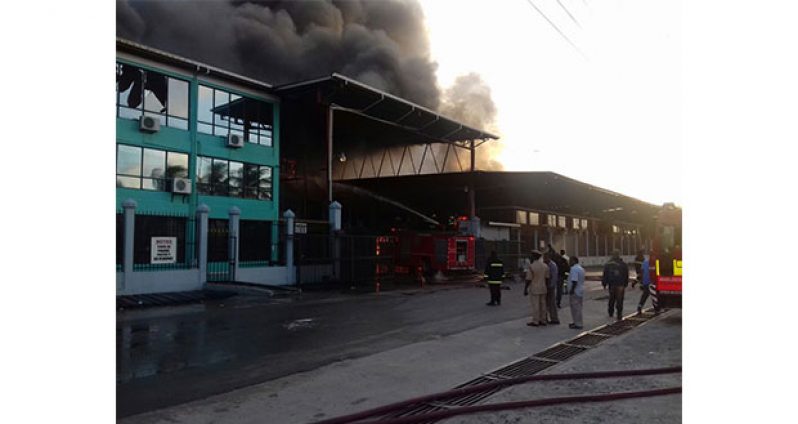–but probe incomplete; questions also raised about building code regulations
By Alva Solomon
AS investigations continue into Monday’s devastating fire at the Gafoors Houston Complex, all evidence indicate that it may have been “accidental”. At the same time, calls have been made for the authorities to enforce the national building code set out by the Guyana National Bureau of Standards (GNBS).
The late afternoon fire leveled seven to eight bonds at the Houston, East Bank Demerara location where large quantities of merchandise, including imported doors, steel equipment, generators, plyboard and thinners used in mixing paint were stored. The remaining seven bonds escaped the blaze.
The fire, which left billions of dollars in losses, was at first said to be electrical in origin. However, Fire Chief Marlon Gentle yesterday told this newspaper that while investigations are ongoing, “We are looking at something accidental.” He made it clear, however, that the investigations are incomplete.
Persons at the scene reported to this newspaper that the fire was first observed in Bond 3 of the sprawling establishment. One staff member recalled seeing smoke coming from the roof of Bond 3, which housed tarpaulins and fishing gear. Smoke was observed in the roof section of the bond where a quantity of Styrofoam was stored.
The fire began around 15:50hrs, and three hours later, the seven to eight bonds, as well as a section of the building east of the bonds which housed other departments, including an administrative block, were gutted.
A section of the building which is under construction escaped the flames. It is at this section that the business is likely to be managed as the company assesses its loss.
The Gafoors Houston Complex is a subsidiary of Gafsons Industries, and Executive Chairman of the company, Sattaur Gafoor told this newspaper on Tuesday that the fire was a huge setback for them. Gafoor said he would like to restart the process of conducting business at the location as early as possible, but he has to wait on the Guyana Fire Service to complete their investigations. The insurance companies would also have to give the ‘green light’ to demolish and repair the damaged structure.
The 530-plus staff members of the complex have since been redeployed to the company’s sister branches across Regions 2 (Pomeroon-Supenaam) and 4 (Demerara-Mahaica).
BUILDING CODE
Meanwhile, members of the public have noted that the authorities should ensure that the 2005 building code regulations are effectively instituted, in light of the Gafoors fire. The Guyana National Building Code of the GNBS sets out minimum requirements regarding the safety of buildings, as aspects of fire protection and structural sufficiency. All buildings, including new structures, shall be in compliance with the codes, the GNBS states.
The Gafoors complex falls within several categories of the regulations, including the mercantile group and the business occupancy category of buildings as set out in the regulations. According to the building code, all buildings and structures, or parts thereof, which are used for the transaction of business or the rendering of professional services, shall be classified in Business (B) occupancy group. Buildings of a similar nature fall in the mercantile category. And, adequate smoke-controlled systems shall be installed to minimize the spread of smoke to escape paths, compartments and other buildings to assist access by fire fighters.
On Monday evening the Fire Chief told members of the media that there were some safety concerns at the scene of the fire, one of which was the layout of the building while the other was the items stored therein, both of which were preventing the firemen from reacting to the situation as readily as they would have liked. “It’s a bond with various types of combustibles,” he said, explaining the tremendous heat the fire was generating.
SPRINKLER SYSTEMS
On social media, persons have suggested that Gafoor and other businesses install sprinkler systems within the buildings. The building code speaks of the installation of a sprinkler system in buildings to aid in the suppression of fires. According to the code, there are four types of automatic fire sprinkler systems. These are water sprinklers (or flood spraying), foam extinguishing systems, carbon dioxide of halogenated suppressive gases and dry chemical extinguishing systems.
While the latter three may be expensive, the availability of water and less complex operation of the water sprinkler systems makes it more affordable and economical for installation at businesses, including sprawling structures such as the Gafoors Houston Complex.





.jpg)








